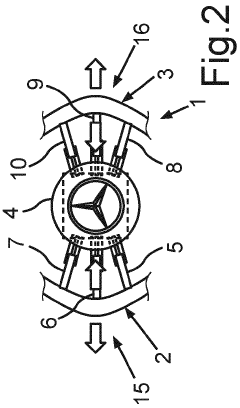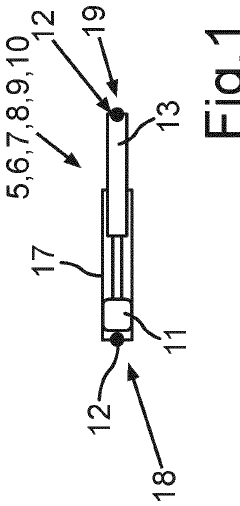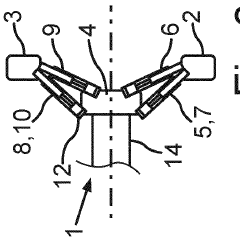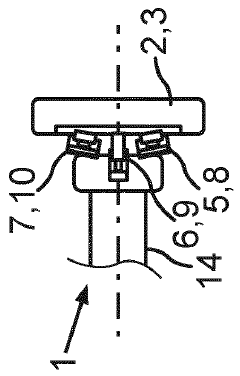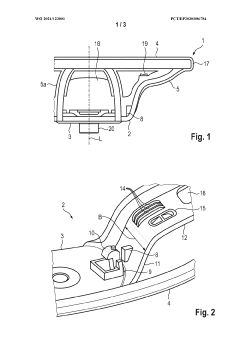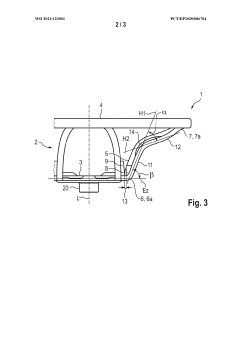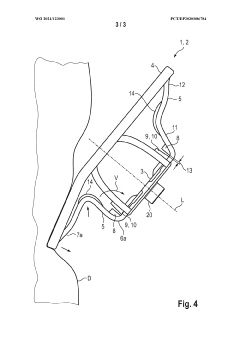Steering Wheel Innovations for Off-Road Vehicles
JUL 18, 20259 MIN READ
Generate Your Research Report Instantly with AI Agent
Patsnap Eureka helps you evaluate technical feasibility & market potential.
Off-road Steering Evolution
The evolution of steering systems for off-road vehicles has been a journey marked by significant technological advancements and innovative solutions. Initially, off-road vehicles relied on simple mechanical steering systems, which were robust but often required considerable physical effort from the driver, especially in challenging terrain.
As off-road vehicles became more popular and diverse in their applications, the need for more sophisticated steering systems became apparent. The introduction of power steering in the 1950s marked a significant milestone, reducing the physical effort required to maneuver these vehicles. This innovation quickly became standard in most off-road vehicles, greatly improving their usability and control.
The next major leap came with the development of hydraulic power steering systems specifically designed for off-road use. These systems offered improved responsiveness and durability, capable of withstanding the harsh conditions often encountered in off-road environments. They provided better feedback to the driver and enhanced the vehicle's ability to navigate difficult terrain.
In the 1990s and early 2000s, electronic power steering (EPS) systems began to emerge in off-road vehicles. EPS offered several advantages over hydraulic systems, including reduced weight, improved fuel efficiency, and the ability to integrate with other vehicle systems. This integration allowed for more advanced features such as variable assist steering, which could adjust steering effort based on vehicle speed and driving conditions.
Recent years have seen the introduction of steer-by-wire technology in off-road vehicles. This system eliminates the mechanical connection between the steering wheel and the wheels, replacing it with electronic controls and actuators. Steer-by-wire offers unprecedented flexibility in steering control and opens up new possibilities for vehicle design and functionality.
The latest frontier in off-road steering innovation is the development of autonomous and semi-autonomous steering systems. These technologies leverage advanced sensors, GPS, and artificial intelligence to assist or even take over steering functions in certain conditions. While still in the early stages for off-road applications, these systems show promise for improving safety, efficiency, and capability in challenging environments.
Throughout this evolution, the focus has remained on improving control, reducing driver fatigue, enhancing vehicle performance, and adapting to the unique challenges of off-road driving. Each advancement has built upon previous technologies, resulting in steering systems that are increasingly sophisticated, reliable, and capable of handling the most demanding off-road conditions.
As off-road vehicles became more popular and diverse in their applications, the need for more sophisticated steering systems became apparent. The introduction of power steering in the 1950s marked a significant milestone, reducing the physical effort required to maneuver these vehicles. This innovation quickly became standard in most off-road vehicles, greatly improving their usability and control.
The next major leap came with the development of hydraulic power steering systems specifically designed for off-road use. These systems offered improved responsiveness and durability, capable of withstanding the harsh conditions often encountered in off-road environments. They provided better feedback to the driver and enhanced the vehicle's ability to navigate difficult terrain.
In the 1990s and early 2000s, electronic power steering (EPS) systems began to emerge in off-road vehicles. EPS offered several advantages over hydraulic systems, including reduced weight, improved fuel efficiency, and the ability to integrate with other vehicle systems. This integration allowed for more advanced features such as variable assist steering, which could adjust steering effort based on vehicle speed and driving conditions.
Recent years have seen the introduction of steer-by-wire technology in off-road vehicles. This system eliminates the mechanical connection between the steering wheel and the wheels, replacing it with electronic controls and actuators. Steer-by-wire offers unprecedented flexibility in steering control and opens up new possibilities for vehicle design and functionality.
The latest frontier in off-road steering innovation is the development of autonomous and semi-autonomous steering systems. These technologies leverage advanced sensors, GPS, and artificial intelligence to assist or even take over steering functions in certain conditions. While still in the early stages for off-road applications, these systems show promise for improving safety, efficiency, and capability in challenging environments.
Throughout this evolution, the focus has remained on improving control, reducing driver fatigue, enhancing vehicle performance, and adapting to the unique challenges of off-road driving. Each advancement has built upon previous technologies, resulting in steering systems that are increasingly sophisticated, reliable, and capable of handling the most demanding off-road conditions.
Market Demand Analysis
The off-road vehicle market has been experiencing significant growth in recent years, driven by increasing consumer interest in outdoor activities and adventure sports. This trend has created a robust demand for innovative steering wheel solutions that can enhance the driving experience and safety of off-road vehicles. Market research indicates that the global off-road vehicle market is expected to reach $28.5 billion by 2026, with a compound annual growth rate (CAGR) of 4.8% from 2021 to 2026.
The demand for advanced steering wheel technologies in off-road vehicles is primarily fueled by the need for improved control and maneuverability in challenging terrains. Off-road enthusiasts and professional drivers alike are seeking steering solutions that can provide better feedback, reduce driver fatigue, and enhance overall vehicle performance. This has led to a growing interest in adaptive steering systems, haptic feedback technologies, and integrated control interfaces within steering wheels.
One of the key market trends driving steering wheel innovations is the increasing focus on driver safety. Off-road vehicles often operate in harsh environments with unpredictable obstacles, making advanced safety features crucial. As a result, there is a rising demand for steering wheels equipped with intelligent systems that can detect potential hazards and assist drivers in maintaining control of their vehicles.
Another significant factor influencing market demand is the integration of digital technologies into off-road vehicle cockpits. Consumers are increasingly expecting smart features and connectivity options in their vehicles, including off-road models. This has created opportunities for steering wheel designs that incorporate touchscreens, voice control systems, and customizable interfaces to enhance the overall driving experience.
The commercial sector also plays a crucial role in shaping the market demand for off-road vehicle steering wheel innovations. Industries such as agriculture, construction, and mining rely heavily on off-road vehicles, and there is a growing need for steering solutions that can improve operator efficiency and reduce downtime. This has led to increased interest in ergonomic designs, fatigue-reducing materials, and steering assist technologies tailored for prolonged use in rugged environments.
Environmental concerns and sustainability initiatives are also influencing market trends in the off-road vehicle sector. As regulations become more stringent, there is a growing demand for steering wheel technologies that can contribute to improved fuel efficiency and reduced emissions. This includes lightweight materials, energy-efficient power steering systems, and designs that optimize vehicle aerodynamics.
In conclusion, the market demand for steering wheel innovations in off-road vehicles is driven by a combination of factors, including consumer preferences, safety requirements, technological advancements, and industry-specific needs. As the off-road vehicle market continues to expand, manufacturers and suppliers will need to focus on developing cutting-edge steering solutions that address these diverse demands while staying ahead of emerging trends and regulatory requirements.
The demand for advanced steering wheel technologies in off-road vehicles is primarily fueled by the need for improved control and maneuverability in challenging terrains. Off-road enthusiasts and professional drivers alike are seeking steering solutions that can provide better feedback, reduce driver fatigue, and enhance overall vehicle performance. This has led to a growing interest in adaptive steering systems, haptic feedback technologies, and integrated control interfaces within steering wheels.
One of the key market trends driving steering wheel innovations is the increasing focus on driver safety. Off-road vehicles often operate in harsh environments with unpredictable obstacles, making advanced safety features crucial. As a result, there is a rising demand for steering wheels equipped with intelligent systems that can detect potential hazards and assist drivers in maintaining control of their vehicles.
Another significant factor influencing market demand is the integration of digital technologies into off-road vehicle cockpits. Consumers are increasingly expecting smart features and connectivity options in their vehicles, including off-road models. This has created opportunities for steering wheel designs that incorporate touchscreens, voice control systems, and customizable interfaces to enhance the overall driving experience.
The commercial sector also plays a crucial role in shaping the market demand for off-road vehicle steering wheel innovations. Industries such as agriculture, construction, and mining rely heavily on off-road vehicles, and there is a growing need for steering solutions that can improve operator efficiency and reduce downtime. This has led to increased interest in ergonomic designs, fatigue-reducing materials, and steering assist technologies tailored for prolonged use in rugged environments.
Environmental concerns and sustainability initiatives are also influencing market trends in the off-road vehicle sector. As regulations become more stringent, there is a growing demand for steering wheel technologies that can contribute to improved fuel efficiency and reduced emissions. This includes lightweight materials, energy-efficient power steering systems, and designs that optimize vehicle aerodynamics.
In conclusion, the market demand for steering wheel innovations in off-road vehicles is driven by a combination of factors, including consumer preferences, safety requirements, technological advancements, and industry-specific needs. As the off-road vehicle market continues to expand, manufacturers and suppliers will need to focus on developing cutting-edge steering solutions that address these diverse demands while staying ahead of emerging trends and regulatory requirements.
Current Challenges
Off-road vehicles face unique challenges in steering wheel design due to the demanding and unpredictable nature of their operating environments. One of the primary challenges is durability and resilience. Steering wheels for off-road vehicles must withstand extreme conditions, including intense vibrations, impacts from rough terrain, and exposure to dust, mud, and moisture. These factors can lead to accelerated wear and tear, potentially compromising the steering wheel's integrity and functionality over time.
Another significant challenge is maintaining optimal grip and control in various conditions. Off-road driving often involves traversing slippery, uneven, or loose surfaces, which can make it difficult for drivers to maintain a firm grip on the steering wheel. This challenge is further compounded by the fact that drivers may be wearing gloves or have wet or muddy hands, necessitating innovative surface textures and materials to ensure consistent grip and control.
Ergonomics and comfort present another set of challenges in off-road steering wheel design. Extended periods of off-road driving can lead to driver fatigue, which is exacerbated by the constant need for precise steering inputs and the physical demands of navigating challenging terrain. Designing a steering wheel that minimizes fatigue while maximizing control and responsiveness is a delicate balance that requires careful consideration of factors such as wheel size, shape, and material composition.
Integration of advanced technologies into off-road steering wheels poses additional challenges. As vehicles become more technologically sophisticated, there is a growing demand for steering wheels that incorporate features such as integrated controls, display screens, and haptic feedback systems. However, implementing these technologies in a way that is robust enough to withstand off-road conditions while remaining user-friendly and not detracting from the primary function of steering control is a complex task.
Weight reduction is another critical challenge in steering wheel innovation for off-road vehicles. While durability is paramount, there is also a need to minimize the overall weight of the vehicle to improve performance and fuel efficiency. This creates a tension between the need for a sturdy, resilient steering wheel and the desire for lightweight components.
Finally, customization and adaptability present ongoing challenges in steering wheel design for off-road vehicles. Different types of off-road driving (e.g., rock crawling, desert racing, mudding) may require different steering wheel characteristics. Developing steering wheels that can be easily customized or adapted to suit various driving styles and terrains, without compromising safety or performance, remains a significant challenge for manufacturers and designers in this field.
Another significant challenge is maintaining optimal grip and control in various conditions. Off-road driving often involves traversing slippery, uneven, or loose surfaces, which can make it difficult for drivers to maintain a firm grip on the steering wheel. This challenge is further compounded by the fact that drivers may be wearing gloves or have wet or muddy hands, necessitating innovative surface textures and materials to ensure consistent grip and control.
Ergonomics and comfort present another set of challenges in off-road steering wheel design. Extended periods of off-road driving can lead to driver fatigue, which is exacerbated by the constant need for precise steering inputs and the physical demands of navigating challenging terrain. Designing a steering wheel that minimizes fatigue while maximizing control and responsiveness is a delicate balance that requires careful consideration of factors such as wheel size, shape, and material composition.
Integration of advanced technologies into off-road steering wheels poses additional challenges. As vehicles become more technologically sophisticated, there is a growing demand for steering wheels that incorporate features such as integrated controls, display screens, and haptic feedback systems. However, implementing these technologies in a way that is robust enough to withstand off-road conditions while remaining user-friendly and not detracting from the primary function of steering control is a complex task.
Weight reduction is another critical challenge in steering wheel innovation for off-road vehicles. While durability is paramount, there is also a need to minimize the overall weight of the vehicle to improve performance and fuel efficiency. This creates a tension between the need for a sturdy, resilient steering wheel and the desire for lightweight components.
Finally, customization and adaptability present ongoing challenges in steering wheel design for off-road vehicles. Different types of off-road driving (e.g., rock crawling, desert racing, mudding) may require different steering wheel characteristics. Developing steering wheels that can be easily customized or adapted to suit various driving styles and terrains, without compromising safety or performance, remains a significant challenge for manufacturers and designers in this field.
Existing Solutions
01 Steering wheel design and ergonomics
Innovations in steering wheel design focus on improving ergonomics and driver comfort. This includes optimizing the shape, size, and grip of the steering wheel to reduce fatigue during long drives and enhance control. Advanced materials and manufacturing techniques are employed to create steering wheels that are both functional and aesthetically pleasing.- Steering wheel design and ergonomics: Innovations in steering wheel design focus on improving ergonomics and driver comfort. This includes optimizing the shape, size, and grip of the steering wheel to reduce fatigue during long drives and enhance control. Some designs incorporate adjustable features to accommodate different driver preferences and body types.
- Integration of controls and displays: Modern steering wheels often integrate various controls and displays to enhance functionality and reduce driver distraction. This can include buttons for audio control, cruise control, and phone operations, as well as small screens or heads-up displays for important vehicle information.
- Safety features in steering wheels: Steering wheel safety features are continuously evolving. This includes improvements in airbag technology, impact-absorbing materials, and designs that minimize injury in the event of a collision. Some innovations focus on integrating sensors for driver monitoring and alertness detection.
- Steering wheel materials and manufacturing: Advancements in materials science and manufacturing techniques are applied to steering wheel production. This includes the use of lightweight yet durable materials, improved grip textures, and manufacturing processes that enhance quality and reduce costs. Some innovations focus on sustainable or recycled materials for eco-friendly production.
- Smart and connected steering wheels: The development of smart and connected steering wheels is an emerging trend. These incorporate advanced sensors and connectivity features to interface with vehicle systems and external devices. Some innovations explore haptic feedback, gesture recognition, and biometric authentication for enhanced driver interaction and security.
02 Integration of controls and displays
Modern steering wheels incorporate various controls and displays to enhance driver convenience and safety. These may include buttons for audio control, cruise control, and phone operations, as well as small screens or heads-up displays for providing important vehicle information without the need to look away from the road.Expand Specific Solutions03 Steering wheel heating and cooling systems
To improve comfort in various weather conditions, steering wheels are being equipped with heating and cooling systems. These systems can quickly adjust the temperature of the steering wheel surface, providing a more pleasant driving experience in extreme hot or cold environments.Expand Specific Solutions04 Advanced safety features in steering wheels
Steering wheels are being designed with advanced safety features to protect drivers in the event of a collision. This includes the integration of airbags, impact-absorbing materials, and collapsible steering columns. Additionally, sensors in the steering wheel can detect driver grip and alertness, contributing to driver assistance systems.Expand Specific Solutions05 Adjustable and customizable steering wheels
Innovations in steering wheel technology allow for greater adjustability and customization. This includes steering wheels that can change shape or size to accommodate different drivers, as well as those that can be easily removed or folded away in autonomous driving modes. Some designs also feature interchangeable grips or covers for personalization.Expand Specific Solutions
Key Industry Players
The steering wheel innovation market for off-road vehicles is in a growth phase, driven by increasing demand for advanced off-road capabilities and enhanced driver experience. The market size is expanding, with major players like Deere & Co., Volvo Lastvagnar AB, and Ford Global Technologies LLC investing in research and development. Technology maturity varies, with established companies like Honda Motor Co., Ltd. and Yamaha Motor Co., Ltd. leveraging their expertise in vehicle systems, while newer entrants like Lantu Automobile Technology Co., Ltd. focus on cutting-edge innovations. The competitive landscape is diverse, including traditional automotive manufacturers, specialized off-road vehicle producers, and technology-focused firms, all vying to develop more sophisticated and user-friendly steering solutions for challenging terrains.
Deere & Co.
Technical Solution: Deere & Co. has developed an innovative steering system for off-road vehicles that combines electrohydraulic and steer-by-wire technologies. This system utilizes advanced sensors and control algorithms to provide precise steering control in challenging terrain. The company has implemented a variable steering ratio that adjusts based on vehicle speed and operating conditions, enhancing maneuverability at low speeds and stability at high speeds[1]. Additionally, Deere & Co. has integrated haptic feedback into the steering wheel, providing the operator with important information about ground conditions and vehicle performance[2].
Strengths: Improved precision and control in varied terrains, enhanced operator feedback. Weaknesses: Potentially higher cost and complexity compared to traditional steering systems.
Ford Global Technologies LLC
Technical Solution: Ford has developed a novel steering wheel system for off-road vehicles that incorporates adaptive grip technology. This system uses embedded sensors to detect the driver's hand position and grip strength, automatically adjusting the steering wheel's resistance and feedback accordingly[3]. The company has also implemented a modular design that allows for quick customization of steering wheel controls based on specific off-road applications. Ford's system includes an integrated display that provides real-time information on vehicle attitude, wheel articulation, and terrain mapping, enhancing the driver's situational awareness in challenging off-road conditions[4].
Strengths: Personalized steering experience, improved driver information integration. Weaknesses: Potential for system complexity and higher maintenance requirements.
Core Innovations
Steering wheel
PatentWO2024046626A1
Innovation
- A steering wheel design featuring at least three telescopic adjustment elements connected to each handle via 3D bearings, allowing for independent adjustment in all spatial dimensions, with optional electromotive, pneumatic, or hydraulic drives for precise length adjustment, and a worm drive for precise control, enabling various positioning options including radial, vertical, and tilting movements.
Steering wheel
PatentWO2021123001A1
Innovation
- The design incorporates a projection at the spoke's first end to limit tilting towards the central area, forming a stop with a gap to prevent spoke detachment, and features an S-shaped curvature with reinforcement structures to allow controlled bending and prevent shearing or breaking, while maintaining material efficiency and accommodating airbag modules.
Material Advancements
Material advancements in steering wheel design for off-road vehicles have significantly enhanced performance, durability, and user experience. Recent innovations focus on lightweight yet robust materials that can withstand extreme conditions while providing optimal grip and control.
Carbon fiber composites have emerged as a game-changing material in steering wheel construction. These materials offer exceptional strength-to-weight ratios, allowing for the creation of ultra-lightweight steering wheels that maintain structural integrity under high-stress situations. Carbon fiber's resistance to fatigue and corrosion makes it ideal for off-road applications where exposure to harsh elements is common.
Advanced polymers and elastomers are being utilized to improve grip and tactile feedback. These materials can be engineered to maintain their properties across a wide range of temperatures and humidity levels, ensuring consistent performance in diverse off-road environments. Some manufacturers are experimenting with hydrophobic coatings to enhance grip in wet conditions, a crucial feature for off-road driving.
Titanium alloys are gaining traction in high-end off-road steering wheel designs. These alloys offer an excellent balance of strength, weight reduction, and corrosion resistance. The use of titanium allows for thinner, more responsive steering wheel structures without compromising on durability.
Smart materials, such as shape memory alloys and piezoelectric materials, are being explored for their potential to create adaptive steering wheels. These materials can change their properties in response to external stimuli, potentially allowing for real-time adjustments in steering wheel rigidity or vibration dampening based on terrain conditions.
Biodegradable and sustainable materials are also making their way into steering wheel design, addressing environmental concerns. Researchers are developing high-performance bio-based composites that could potentially replace traditional petroleum-based materials without sacrificing performance or durability.
Nanotechnology is playing a crucial role in enhancing material properties. Nanoparticle reinforcements in polymer matrices can significantly improve strength, wear resistance, and thermal stability of steering wheel materials. This technology enables the creation of multifunctional materials that can simultaneously address multiple performance requirements.
The integration of these advanced materials is not without challenges. Manufacturers must balance performance gains with cost considerations, as many of these materials are significantly more expensive than traditional options. Additionally, the long-term durability and recyclability of some advanced composites remain areas of ongoing research and development.
Carbon fiber composites have emerged as a game-changing material in steering wheel construction. These materials offer exceptional strength-to-weight ratios, allowing for the creation of ultra-lightweight steering wheels that maintain structural integrity under high-stress situations. Carbon fiber's resistance to fatigue and corrosion makes it ideal for off-road applications where exposure to harsh elements is common.
Advanced polymers and elastomers are being utilized to improve grip and tactile feedback. These materials can be engineered to maintain their properties across a wide range of temperatures and humidity levels, ensuring consistent performance in diverse off-road environments. Some manufacturers are experimenting with hydrophobic coatings to enhance grip in wet conditions, a crucial feature for off-road driving.
Titanium alloys are gaining traction in high-end off-road steering wheel designs. These alloys offer an excellent balance of strength, weight reduction, and corrosion resistance. The use of titanium allows for thinner, more responsive steering wheel structures without compromising on durability.
Smart materials, such as shape memory alloys and piezoelectric materials, are being explored for their potential to create adaptive steering wheels. These materials can change their properties in response to external stimuli, potentially allowing for real-time adjustments in steering wheel rigidity or vibration dampening based on terrain conditions.
Biodegradable and sustainable materials are also making their way into steering wheel design, addressing environmental concerns. Researchers are developing high-performance bio-based composites that could potentially replace traditional petroleum-based materials without sacrificing performance or durability.
Nanotechnology is playing a crucial role in enhancing material properties. Nanoparticle reinforcements in polymer matrices can significantly improve strength, wear resistance, and thermal stability of steering wheel materials. This technology enables the creation of multifunctional materials that can simultaneously address multiple performance requirements.
The integration of these advanced materials is not without challenges. Manufacturers must balance performance gains with cost considerations, as many of these materials are significantly more expensive than traditional options. Additionally, the long-term durability and recyclability of some advanced composites remain areas of ongoing research and development.
Ergonomic Considerations
Ergonomic considerations play a crucial role in the design and innovation of steering wheels for off-road vehicles. The unique challenges presented by off-road terrain demand a steering system that not only provides precise control but also ensures driver comfort and safety during extended periods of operation.
One of the primary ergonomic factors to consider is the grip design of the steering wheel. Off-road driving often involves sudden jolts and vibrations, requiring a firm and comfortable grip to maintain control. Manufacturers are exploring various materials and textures to enhance grip without causing fatigue during long drives. Some innovative approaches include the use of high-friction rubber compounds and strategically placed indentations or protrusions that naturally fit the contours of the driver's hands.
The shape and size of the steering wheel also significantly impact ergonomics. Traditional circular designs are being reevaluated, with some manufacturers opting for slightly flattened bottom sections or even D-shaped wheels. These modifications can provide more knee clearance and improved ingress and egress, particularly beneficial in vehicles with limited cabin space. Additionally, the diameter of the wheel is being optimized to balance the need for leverage in low-speed maneuvering with the desire for quick responsiveness at higher speeds.
Another area of focus is the integration of controls into the steering wheel itself. As off-road vehicles become more technologically advanced, there is a growing need to access various functions without removing hands from the wheel. Ergonomic placement of buttons and switches for features such as communication systems, navigation, and vehicle mode selection is crucial. Some innovative designs incorporate haptic feedback or raised tactile indicators to allow for operation without visual confirmation, enhancing safety during challenging driving conditions.
The angle and adjustability of the steering column are also receiving attention in ergonomic research. Off-road driving often requires a more upright seating position for better visibility and control. Steering systems that offer a wide range of tilt and telescopic adjustments allow drivers of different sizes to find their optimal position, reducing fatigue and improving overall driving experience.
Vibration dampening is another critical aspect of steering wheel ergonomics for off-road vehicles. Excessive vibration can lead to driver fatigue and reduced control precision. Advanced materials and construction techniques are being employed to isolate the steering wheel from harsh terrain-induced vibrations while still maintaining necessary feedback for the driver.
In conclusion, ergonomic considerations in steering wheel design for off-road vehicles are multifaceted, encompassing grip, shape, control integration, adjustability, and vibration management. These factors collectively contribute to enhanced driver comfort, control, and safety in challenging off-road environments.
One of the primary ergonomic factors to consider is the grip design of the steering wheel. Off-road driving often involves sudden jolts and vibrations, requiring a firm and comfortable grip to maintain control. Manufacturers are exploring various materials and textures to enhance grip without causing fatigue during long drives. Some innovative approaches include the use of high-friction rubber compounds and strategically placed indentations or protrusions that naturally fit the contours of the driver's hands.
The shape and size of the steering wheel also significantly impact ergonomics. Traditional circular designs are being reevaluated, with some manufacturers opting for slightly flattened bottom sections or even D-shaped wheels. These modifications can provide more knee clearance and improved ingress and egress, particularly beneficial in vehicles with limited cabin space. Additionally, the diameter of the wheel is being optimized to balance the need for leverage in low-speed maneuvering with the desire for quick responsiveness at higher speeds.
Another area of focus is the integration of controls into the steering wheel itself. As off-road vehicles become more technologically advanced, there is a growing need to access various functions without removing hands from the wheel. Ergonomic placement of buttons and switches for features such as communication systems, navigation, and vehicle mode selection is crucial. Some innovative designs incorporate haptic feedback or raised tactile indicators to allow for operation without visual confirmation, enhancing safety during challenging driving conditions.
The angle and adjustability of the steering column are also receiving attention in ergonomic research. Off-road driving often requires a more upright seating position for better visibility and control. Steering systems that offer a wide range of tilt and telescopic adjustments allow drivers of different sizes to find their optimal position, reducing fatigue and improving overall driving experience.
Vibration dampening is another critical aspect of steering wheel ergonomics for off-road vehicles. Excessive vibration can lead to driver fatigue and reduced control precision. Advanced materials and construction techniques are being employed to isolate the steering wheel from harsh terrain-induced vibrations while still maintaining necessary feedback for the driver.
In conclusion, ergonomic considerations in steering wheel design for off-road vehicles are multifaceted, encompassing grip, shape, control integration, adjustability, and vibration management. These factors collectively contribute to enhanced driver comfort, control, and safety in challenging off-road environments.
Unlock deeper insights with Patsnap Eureka Quick Research — get a full tech report to explore trends and direct your research. Try now!
Generate Your Research Report Instantly with AI Agent
Supercharge your innovation with Patsnap Eureka AI Agent Platform!
